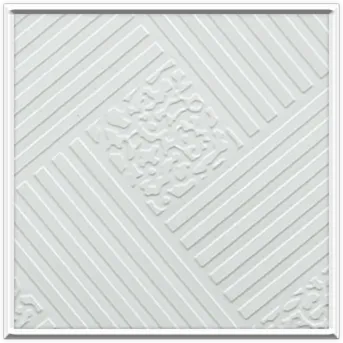10 月 . 09, 2024 10:22 Back to list
suspended ceiling t bar
Understanding Suspended Ceiling T-Bar Systems
Suspended ceiling T-Bar systems have become an integral part of modern building design and interior aesthetics. They offer both functional and aesthetic benefits, making them a popular choice in a variety of settings, from commercial office spaces to residential homes. This article explores the components, installation, benefits, and considerations associated with suspended ceiling T-Bar systems.
What is a Suspended Ceiling T-Bar?
A suspended ceiling, often referred to as a drop ceiling, involves a grid system that holds acoustic tiles or panels below the original ceiling. The T-Bar, which is a key element of this system, refers to the T-shaped metal framing that supports the ceiling tiles. The main components include the main tees, cross tees, and wall angles, which together form a grid that can accommodate tiles of various dimensions.
Components of T-Bar Systems
1. Main Tees These are the long T-shaped strips that run either parallel or perpendicular to the space. They are typically available in lengths ranging from 12 to 16 feet.
2. Cross Tees These connect the main tees and create the grid necessary to hold the ceiling tiles securely. Cross tees are shorter than main tees and are often adjustable to fit different tile sizes.
3. Wall Angles These are installed along the perimeter of the room to provide support for the grid. They ensure that the rest of the grid remains level and securely fastened.
4. Ceiling Tiles The decorative and functional surface of a suspended ceiling, these tiles can be made from various materials, including mineral fiber, wood, and metal. They offer the finishing touch to the grid system.
Installation Process
Installing a suspended ceiling T-Bar system involves several steps
1. Planning and Measurement Accurate measurements are crucial. The dimensions of the room determine how many main tees, cross tees, and tiles are needed. It is essential to mark the desired height of the ceiling on the walls.
2. Installing Wall Angles Once the height is determined, wall angles are attached to the walls with screws, following the marked line around the room.
3. Hanging Main Tees The main tees are then hung from the ceiling using suspension wires. This step requires careful adjustment to ensure that the main tees are level.
suspended ceiling t bar

4. Adding Cross Tees After the main tees are in position, cross tees are inserted at intervals to complete the grid.
5. Fitting Ceiling Tiles Finally, tiles are placed into the grid. This step is where the aesthetic aspect comes in, as the tiles can be chosen based on style and functionality, such as acoustic properties.
Benefits of T-Bar Systems
Suspended ceiling T-Bar systems come with a multitude of benefits
- Aesthetic Flexibility They can accommodate a wide range of materials and finishes, allowing for creative designs that suit any interior.
- Acoustic Control Many ceiling tiles are designed to absorb sound, making them ideal for settings such as offices, schools, and hospitals where noise control is crucial.
- Accessibility The space above a suspended ceiling is often used for wiring, plumbing, and HVAC systems. T-Bar ceilings provide easy access to these systems without the need for extensive demolition.
- Energy Efficiency An insulated suspended ceiling can help regulate indoor temperatures, leading to energy savings.
Considerations
While T-Bar systems offer many advantages, several considerations should be taken into account
- Weight Limitations Each T-Bar system has specific weight limits that must be adhered to. Heavy light fixtures or decorations cannot be directly mounted on the ceiling tiles.
- Moisture In environments with high humidity, it is crucial to use moisture-resistant tiles and ensure adequate ventilation to avoid mold growth.
- Installation Expertise Although the installation process can be straightforward, it may require professional help to ensure that the ceiling is level, secure, and aesthetically pleasing.
In conclusion, suspended ceiling T-Bar systems represent a versatile, practical, and stylish solution for various interior spaces. Whether you are looking to enhance your office or create a cozy home environment, understanding the components and benefits of these systems can lead to informed decisions that elevate your interior design. With proper planning and execution, T-Bar ceilings can significantly enhance both functionality and aesthetics in any space.
-
Revolutionizing Interior Design with Ceilings t grid Suspended SystemNewsOct.29,2024
-
Revolutionizing Ceiling Design with ceiling access panel with Gypsum Tile WaterproofNewsOct.29,2024
-
Revolutionizing Interior Design with PVC Gypsum Ceiling: A Comprehensive GuideNewsOct.29,2024
-
Elevating Interior Design with High quality Mineral Fiber Ceiling TilesNewsOct.29,2024
-
Revolutionizing Interior Design with PVC Gypsum Ceiling: A Comprehensive GuideNewsOct.29,2024
-
Elevating Interior Design with High-Quality Mineral Fiber Ceiling Tiles: A Comprehensive GuideNewsOct.29,2024







